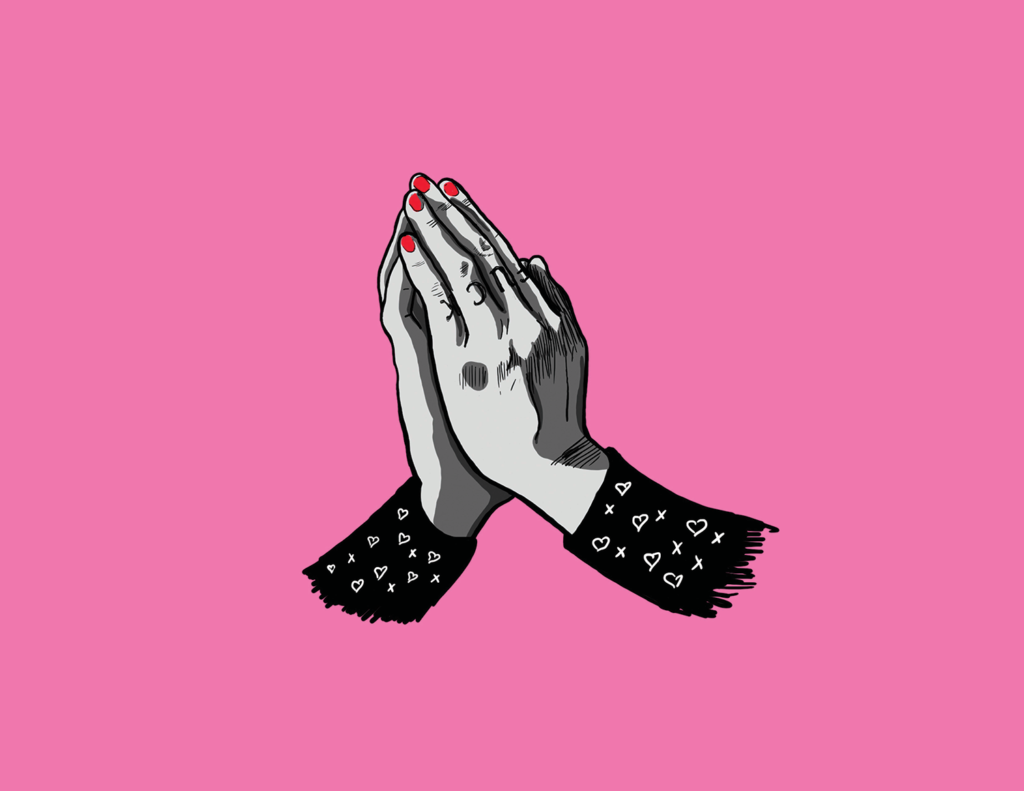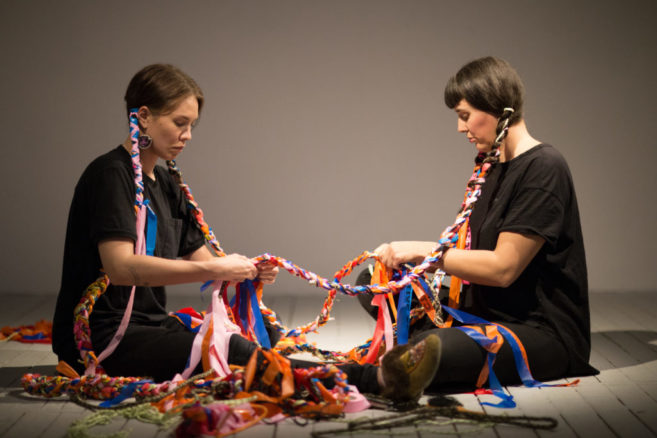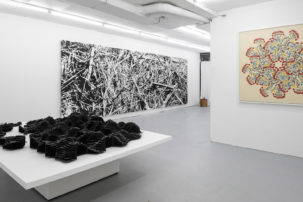Atikamekw artist Meky Ottawa is a bit of a Montreal scene girl. You can regularly find her on a terrace at the back of an underground music venue in Mile End, always smiling and laughing. (That is, if you can call the backyard of an apartment-turned-secret-venue directly on the train tracks, with wooden two-by-fours modified into DIY benches—the kind of place where the whole local NDN crew shows up—a terrace.) When I first met Ottawa she immediately reached out and gave me a hug. I complimented the quality of her wool coat, which was soft to touch: very city-NDN-femme, bougie Native vibes. “I know. I got good shit, hein,” she replied in that perfect Franglais that lets you know she’s a local. I smiled. Ottawa is a Native femme’s femme, and she knows how to make a kwe feel at home, even on the train tracks somewhere in the belly of Montreal’s after-hours scene.
The question of Indigenous aesthetics seems to be on the mind of her generation. Indigenous aesthetics have, at times, been suffocating for younger artists who want to create work based on their contemporary realities without tokenizing themselves, their backgrounds or their experiences. Yet there still exists a pressure to monetize or adapt one’s aesthetics to be more normatively Indigenous, to fit into a mold of performative aesthetics and be encompassed under a lineage of what has traditionally been considered Indigenous fine art. Kablusiak succinctly noted this in an interview about their Sobey Award nomination: “I’d like to just make art without having to deal with the crushing weight of cultural identity and what that’s supposed to look like in today’s world.”
For her recent exhibition at La Guilde in Montreal, “Nehirowisidigital,” Ottawa represents NDN grrrls in all the cities, at all the after-hours and metal shows, all the play parties and strip clubs. Ottawa’s collection of illustrations at La Guilde exhibits something I want to call femDNsthetics. “Fem” refers to both feminism and “femme” communities, encompassing fluid, queer and trans expressions of feminity; “DN” borrows from the slang term “NDN,” which is a term millennial and GenZ Indigenous folks often use to refer to themselves online. This “femDN” aesthetics—femDNsthetics—is an emergent mode of intervention among this NDN bad grrrl generation who seek diverse forms of representation relevant to their own lives, a witnessing of one another, not an aesthetics made for a Canadian public accustomed to being spoon fed Indigeneity in easily readable forms. Against the formalist aesthetics of high pretention that hang on the walls of beaux-art galleries, Meky Ottawa and her generation choose a punk-rock, anti-aesthetic instead.

Meky Ottawa, Ickwecic matcike ickinikcic, 2017. Ink jet print. Courtesy of La Guilde.

Meky Ottawa, Buffalo, 2017. Ink jet print. Courtesy of La Guilde.

Meky Ottawa, Atosak, 2017. Ink jet print. Courtesy of La Guilde.
So, what are the defining characteristics of femDNsthetics? There are digital drawings or pencil drawings, which are often done by hand—the linework crudely references photocopied zines and flyers for punk shows—such as Ottawa’s digital illustration Amen (2017), which depicts praying hands with painted nails and knuckle tattoos that spell out “FUCK.” The hands are positioned in front of a fluorescent pink background. Indeed, splashes of bright pinks and pastel purples appear throughout “Nehirowisidigital.” Buffalo (2017) shows a pink buffalo in front of a darker pink-red background. Our Elders called for red power, but we imagine pink power and herds of pink buffalo once again running across the plains. Rows of pink spearheads presented anthropologically appear on a purple background in Atosak (2017), as if they are stand-ins for the NDN femmes whose modern lives are still made ethnographic within museums. In the window for the show, facing the street, there is a print of two Indigenous femmes with hair braided so tightly it must have been done by a sister or mother. The pink and purple hue of the figures mark braiding as an NDN femme ritual made sacred because it is shared with other feminine kin. The prevalence of “cute” colours normatively considered feminine is another defining feature of femDNsthetics. Hues of pink and purple are subtle references to shared cultures of girlhoods, and reminiscent of feminist punk-rock music scenes—like Riot Grrrl or Japanese kawaii—that aesthetically expose the reactive misogyny girls experience (and jam with aspects of camp and absurdity as adults).
Meky Ottawa is leading a generation of creators who are contending with new, ethical forms of Indigenous aesthetics made for the future of Indigenous art. Of course, Indigenous millenials and GenZ Indigenous artists have inherited Indigenous culture in their lives, but they are also creating new forms of culture with what their lives look like right here, right now. Indigenous peoples have always been industrious, with adaptive understandings of ceremony, tradition and Indigenous knowledge production. Ottawa wants to represent these peoples—all the NDN grrrls she cackles into the night with on terraces across Montreal and all the NDN grrrls doing the same in cities across Turtle Island. Just like her tongue-in-cheek Indian Names installations, which pokes fun at everything from settlers who appropriate Indigenous identity to inside-jokes about The Rez, Ottawa makes sarcastic work that almost begrudgingly speaks to her indigeneity: why should she flaunt any aspect of her identity other than her own aesthetic concerns, those of a millennial Atikamekw woman, or, worse, modify her message to be more easily consumed by settlers? Ottawa has nothing to prove, and this aspect of fem refusal, through humour, is perhaps the defining quality of a femDNsthetics movement.
 Meky Ottawa, Indian Names, 2017, Ink jet print. Courtesy of La Guilde.
Meky Ottawa, Indian Names, 2017, Ink jet print. Courtesy of La Guilde.

 Meky Ottawa, Amen, 2017. Ink jet print. Courtesy of La Guilde.
Meky Ottawa, Amen, 2017. Ink jet print. Courtesy of La Guilde.






